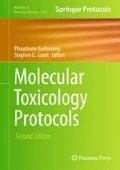Abstract
A fully optimized staining method for detecting sister chromatid exchanges in cultured cells is presented. The method gives reproducibly robust quantitative results. Sister chromatid exchange is a classic toxicology assay for genotoxicity and for detecting alterations to the biochemistry underlying cellular homologous recombination. Growth of cells in the presence of 5′-bromo-deoxyuridine for two rounds of DNA replication followed by collecting metaphase spreads on glass slides, treatment with the UV-sensitive dye Hoechst 33258, long-wave UV light exposure, and Giemsa staining gives a permanent record of the exchanges.
Access this chapter
Tax calculation will be finalised at checkout
Purchases are for personal use only
References
Rothkamm K, Kruger I, Thompson LH, Lobrich M (2003) Pathways of DNA double-strand break repair during the mammalian cell cycle. Mol Cell Biol 23:5706–5715
Helleday T (2010) Homologous recombination in cancer development, treatment and development of drug resistance. Carcinogenesis 31:955–960
Reliene R, Bishop AJ, Schiestl RH (2007) Involvement of homologous recombination in carcinogenesis. Adv Genet 58:67–87
Kyle S, Thomas HD, Mitchell J, Curtin NJ (2008) Exploiting the Achilles heel of cancer: the therapeutic potential of poly(ADP-ribose) polymerase inhibitors in BRCA2-defective cancer. Br J Radiol 81(Spec. No. 1):S6–S11
Ashworth A (2008) A synthetic lethal therapeutic approach: poly(ADP) ribose polymerase inhibitors for the treatment of cancers deficient in DNA double-strand break repair. J Clin Oncol 26:3785–3790
Schultz N, Lopez E, Saleh-Gohari N, Helleday T (2003) Poly(ADP-ribose) polymerase (PARP-1) has a controlling role in homologous recombination. Nucleic Acids Res 31: 4959–4964
Wilson DM III, Thompson LH (2007) Molecular mechanisms of sister-chromatid exchange. Mutat Res 616:11–23
Perry P, Evans HJ (1975) Cytological detection of mutagen-carcinogen exposure by sister chromatid exchange. Nature 258:121–125
Thompson LH (2005) Unraveling the Fanconi anemia–DNA repair connection. Nat Genet 37:921–922
Killen MW, Stults DM, Adachi N, Hanakahi L, Pierce AJ (2009) Loss of Bloom syndrome protein destabilizes human gene cluster architecture. Hum Mol Genet 18:3417–3428
Wolff S, Afzal V (1996) Segregation of DNA polynucleotide strands into sister chromatids and the use of endoreduplicated cells to track sister chromatid exchanges induced by crosslinks, alkylations, or x-ray damage. Proc Natl Acad Sci U S A 93:5765–5769
Perry P, Wolff S (1974) New Giemsa method for the differential staining of sister chromatids. Nature 251:156–158
Yankiwski V, Noonan JP, Neff NF (2001) The C-terminal domain of the Bloom syndrome DNA helicase is essential for genomic stability. BMC Cell Biol 2:11
Pinkel D, Thompson LH, Gray JW, Vanderlaan M (1985) Measurement of sister chromatid exchanges at very low bromodeoxyuridine substitution levels using a monoclonal antibody in Chinese hamster ovary cells. Cancer Res 45: 5795–5798
Stoddart MJ (2011) Cell viability assays: an introduction. Methods Mol Biol 740:1–6
Author information
Authors and Affiliations
Corresponding author
Editor information
Editors and Affiliations
Rights and permissions
Copyright information
© 2014 Humana Press
About this protocol
Cite this protocol
Stults, D.M., Killen, M.W., Pierce, A.J. (2014). The Sister Chromatid Exchange (SCE) Assay. In: Keohavong, P., Grant, S. (eds) Molecular Toxicology Protocols. Methods in Molecular Biology, vol 1105. Humana Press, Totowa, NJ. https://doi.org/10.1007/978-1-62703-739-6_32
Download citation
DOI: https://doi.org/10.1007/978-1-62703-739-6_32
Published:
Publisher Name: Humana Press, Totowa, NJ
Print ISBN: 978-1-62703-738-9
Online ISBN: 978-1-62703-739-6
eBook Packages: Springer Protocols

